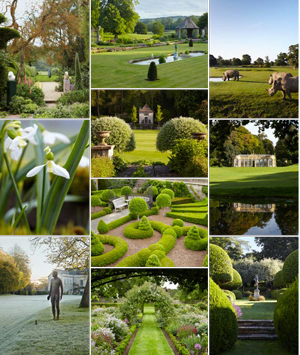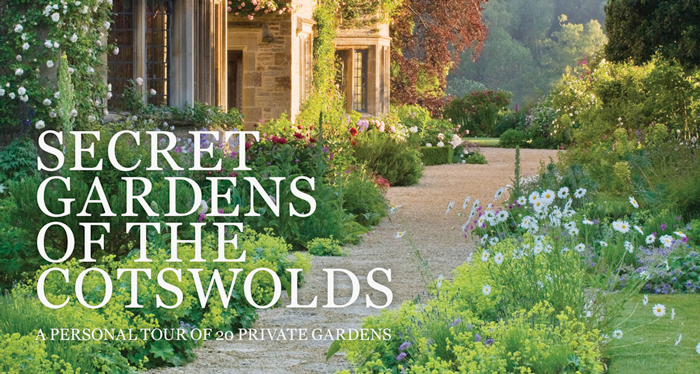‘Secret Gardens of the Cotswolds’
I always think there is something rather delicious and exciting about unearthing the secrets of gardens not normally open, or rarely open to the public. Behind the high hedges and flint walls hidden from the passer-by, there remains that air of mystery, of ‘what might be’ beyond.
So I welcome Victoria Summerley’s ‘Secret Gardens of the Cotswolds’ – a personal tour of 20 private gardens – for the opportunity it presents to help us experience and have an insight into gardens we might otherwise not know exist. The added bonus is that they are all situated in the Cotswolds, where there is a cornucopia of excellent gardens and skilled garden makers.
In the Introduction, the author mirrors my own thoughts exactly when she points out: “Throughout history the notion of a secret garden has cast a spell over us, whether it is the hortus conclusus of Renaissance art and literature or the classic children’s story by Frances Hodgson Burnett.” For the author, the chance to explore some of these Cotswolds ‘secrets’ for the purpose of writing the book became irresistible.
 Not all the gardens included are necessarily completely secret, some open one day a year for charity, or for three days of the week (such as Sezincote and Bourton House) during summer. Indeed, of the 20 gardens included in the book there are only six gardens not open at all to the public, so correctly we can describe them in that sense as ‘secret’. This is deliberate for the author appreciated that it would be rather frustrating for readers if they had no chance of seeing any of the gardens listed.
Not all the gardens included are necessarily completely secret, some open one day a year for charity, or for three days of the week (such as Sezincote and Bourton House) during summer. Indeed, of the 20 gardens included in the book there are only six gardens not open at all to the public, so correctly we can describe them in that sense as ‘secret’. This is deliberate for the author appreciated that it would be rather frustrating for readers if they had no chance of seeing any of the gardens listed.
By their very nature, some gardens in the Cotswolds, as elsewhere, are in danger of being unrecorded in any great detail and with this in mind the author sets out to bring to our attention gardens of which we might otherwise be ignorant. From the cherished snowdrop fields of the Elwes family at Colesbourne to Anthony Gormley’s statue in the garden of Matthew Freud and Elisabeth Murdoch, the author uncovers the various and intriguing ways these Cotswolds gardens inspire and enchant.
There is excellent photography from Hugo Rittson-Thomas (whose own garden at Walcot House, Charlbury is included). He perfectly encapsulates the atmosphere and dynamics of each garden so that we can experience something of their magic and mystique from our armchairs. We find a delightful mix of plants, buildings and vistas, perfectly setting each garden in its environment so that we leave each house and garden with the impression that we have actually visited and enjoyed those sights too.
I liked the inclusion of photographs of the owners and in some cases the gardeners who work either part or full-time alongside their owners – bringing a personal touch to each entry. The historical and background detail of each garden is just the right length to set the scene and the writing style is both informative and relaxed. Throughout its pages we follow in the footsteps of iconic designers such as Repton, Rosemary Verey, Isabel and Julian Bannerman and Mary Keen offering a wide variety of styles and moods.
 The author’s dedication in ensuring that her glimpse over the garden walls or yew hedges of these secret gardens has resulted in giving us an insight into a world which is slowly disappearing. A hundred years ago, such properties would have numerous gardeners to tend the lawns and flowerbeds, today, there may be only one or two, often part-time workers.
The author’s dedication in ensuring that her glimpse over the garden walls or yew hedges of these secret gardens has resulted in giving us an insight into a world which is slowly disappearing. A hundred years ago, such properties would have numerous gardeners to tend the lawns and flowerbeds, today, there may be only one or two, often part-time workers.
Some owners often make up the deficit in manpower, some of them defying advancing years and arthritic hips to do so. Several owners took over their gardens when they were derelict, full of ground elder or overgrown and weed strewn. When the owners of Eastleach House took over 30 years ago, they were greeted with a derelict garden covered in ivy. Today, the garden has been transformed into 14 acres of formal gardens and parkland.
At Upton Wold, Moreton-in-Marsh, there was little more than a farmyard when the present owners arrived. They have spent the past 30 years restoring and creating the gardens which are now home to the National Collection of Walnuts.
Others inherited their landscapes from forebears, each having their own impact on the form and design of the garden. Some owners have kept the quintessentially English character of their garden but added to it as at Dean Manor where new garden rooms have been added.
Victoria Summerley is an award-winning garden journalist and was executive editor of the Independent newspaper in the UK. Hugo Rittson-Thomas is one of the UK’s leading portrait photographers.
‘Secret Gardens of the Cotswolds’ by Victoria Summerley, is published by Frances Lincoln – www.franceslincoln.com – in hardback.


